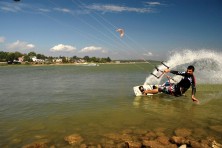Silent Sports Column
- Share
- Tweet
- Pin
- Share
So you ran the Door County Half Marathon and finally took off your finisher’s medal. It’s time to look toward the next endurance challenge.
Perhaps it’s a cycling event like the Peninsula Century Spring Classic. Or maybe you will be lining up next to me at the Door County Triathlon in July. But after months and miles of running, how do you change gears to be sure that you’re not the fastest runner on the day of a bike race?
General fitness is not the same as sport-specific fitness. Thirty minutes of cardio a few times a week may be the U.S. government’s recommendations for good health (indulge in the 63-page Physical Activity Guidelines for Americans produced by the U.S. Department of Health and Human Services), but that is not the best practice for athletes competing in a specific event.
Different sports demand different body types. While things like broad shoulders or a long torso are not easily changed, body fat percentage and muscular power versus endurance can be manipulated with training.
In short, running favors a very low body fat percentage and lean strength. Runners must carry every pound and push that weight against gravity with each stride. The body builder may be strong, but having to haul those heavy muscles over several miles will wear anybody out.
A good body type for cycling is a bit cloudier. Large, heavy, powerful legs will help the athlete on a flat course or during a triathlon battling the wind. But small lightweights will win over the larger athletes when it comes to climbing hills or riding in groups where they can tuck in behind other riders more effectively.
Swimming also falls under the category of it depends. Short sprinters, or those competing in sprint triathlons such as Door County’s, which boasts the shortest swim distance of any race I’ve competed in, benefit from lean muscle and minimum body fat. Longer courses are advantageous to those with a higher percentage of body fat. This provides some extra buoyancy and can also serve to keep you warm when spending upwards of an hour in a cold lake with little more than some Spandex to keep you warm.
Triathletes must balance each of these goal body types to get across the finish line fastest. When I was strictly a cyclist, my tree-trunk legs (as they are often called in the cycling world) would place me first off the bike but leave me struggling on the run. After finishing the Fall 50 ultra-marathon, my legs slimmed down and I found the lean muscle beneficial to the runner.
Tailoring your training to achieve the body type that will serve your endurance events best is one way of approaching your goal times.


